Related Research Articles

The North Sea lies between Great Britain, Denmark, Norway, Germany, the Netherlands, Belgium and France. An epeiric sea on the European continental shelf, it connects to the Atlantic Ocean through the English Channel in the south and the Norwegian Sea in the north. It is more than 970 kilometres (600 mi) long and 580 kilometres (360 mi) wide, covering 570,000 square kilometres (220,000 sq mi).

The Scandinavian Peninsula is a peninsula located in Northern Europe, which roughly comprises the mainlands of Sweden, Norway and the northwestern area of Finland.
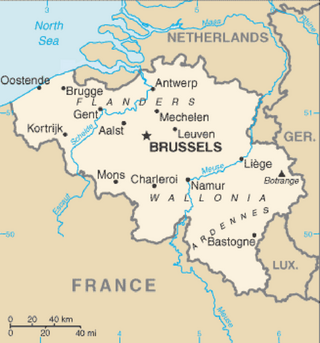
Belgium is a federal state located in Western Europe, bordering the North Sea. Belgium shares borders with France (556 km), Germany (133 km), Luxembourg (130 km) and the Netherlands (478 km). Belgium is divided into three regions: Flanders, Wallonia and Brussels.
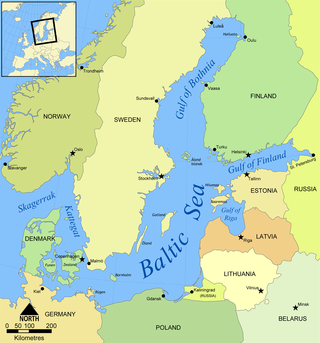
The terms Baltic Sea Region, Baltic Rim countries, and the Baltic Sea countries/states refer to slightly different combinations of countries in the general area surrounding the Baltic Sea, mainly in Northern Europe. The term "Baltic states" refers specifically to one such grouping.
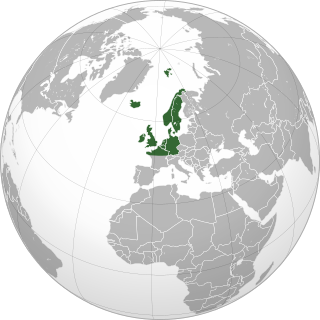
Northwestern Europe, or Northwest Europe, is a loosely defined subregion of Europe, overlapping Northern and Western Europe. The region can be defined both geographically and ethnographically.

Europe, the westernmost portion of Eurasia, is often divided into regions and subregions based on geographical, cultural or historical factors. Since there is no universal agreement on Europe's regional composition, the placement of individual countries may vary based on criteria being used. For instance, the Balkans is a distinct geographical region within Europe but individual countries may alternatively be grouped into South-eastern Europe, Southern Europe or less commonly, Eastern Europe.
The North Sea Commission (NSC) is an international organization founded in 1989. It facilitates partnerships between regions connected with the North Sea and promotes the North Sea Region as an economic entity within Europe. It is part of the Conference of Peripheral Maritime Regions, a pan-European organization for subnational governments.
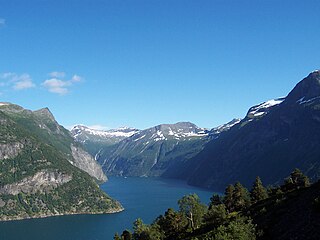
Western Norway is the region along the Atlantic coast of southern Norway. It consists of the counties Rogaland, Vestland, and Møre og Romsdal. The region has no official or political-administrative function. The region has a population of approximately 1.4 million people. The largest city is Bergen and the second-largest is Stavanger. Historically the regions of Agder, Vest-Telemark, Hallingdal, Valdres, and northern parts of Gudbrandsdal have been included in Western Norway.

European route E18 runs from Craigavon in Northern Ireland to Saint Petersburg in Russia, passing through Scotland, England, Norway, Sweden and Finland. It is about 1,890 kilometres in length.
Interreg is a series of programmes to stimulate cooperation between regions in and out of the European Union (EU), funded by the European Regional Development Fund. The first Interreg started in 1989. Interreg IV covered the period 2007–2013. Interreg V (2014–2020) covers all 27 EU member states, the EFTA countries, six accession countries and 18 neighbouring countries. It has a budget of EUR 10.1 billion, which represents 2.8% of the total of the European Cohesion Policy budget. Since the non EU countries don't pay EU membership fee, they contribute directly to Interreg, not through ERDF.

The Copenhagen metropolitan area or Metropolitan Copenhagen is a large commuter belt surrounding Copenhagen, the capital of Denmark. It includes Copenhagen Municipality, Frederiksberg and surrounding municipalities stretching westward across Zealand. It has a densely-populated core surrounded by suburban settlements.
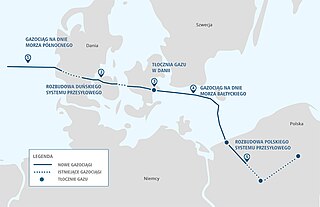
The Baltic Pipe is a natural gas pipeline between Europipe II and Poland. It is a strategic infrastructure project to create a new European gas supply corridor.
The Baltic Sea Region Programme 2007–2013 is a support programme part-financed by the European Union and Norway. It is one of the mainstream Structural Funds programmes under the European Community's territorial co-operation objective. The Programme will support transnational projects working together for balanced and sustainable development of the European territory.
TenneT is a transmission system operator in the Netherlands and in a large part of Germany.

The North Sea Trail is a transnational long-distance hiking trail along the coast of the North Sea. The route passes through seven countries and 26 partner areas. The aim of the project is to promote sustainable tourism and to keep alive the common cultural heritage of the North Sea countries. The trail has a theoretical total length of about 4,900 kilometres (3,000 mi), but so far only about 3,700 kilometres (2,300 mi) have been developed.
The Interreg North SeaProgramme 2021–2027 supports cooperation projects connecting regions in seven countries around the North Sea.

Denmark–Norway was an early modern multi-national and multi-lingual real union consisting of the Kingdom of Denmark, the Kingdom of Norway, the Duchy of Schleswig, and the Duchy of Holstein. The state also claimed sovereignty over three historical peoples: Frisians, Gutes and Wends. Denmark–Norway had several colonies, namely the Danish Gold Coast, the Nicobar Islands, Serampore, Tharangambadi, and the Danish West Indies. The union was also known as the Dano-Norwegian Realm, Twin Realms (Tvillingerigerne) or the Oldenburg Monarchy (Oldenburg-monarkiet)
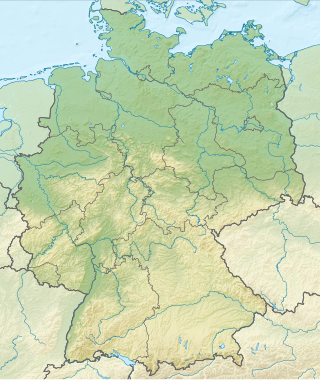
Germany is a country in Central Europe, that stretches from the Alps, across the North European Plain to the North Sea and the Baltic Sea. It is the second-most populous country in Europe after Russia, and is seventh-largest country by area in the continent. The area of Germany ranked 63rd and covers 357,021 km2 (137,847 sq mi), consisting of 349,223 km2 (134,836 sq mi) of land and 7,798 km2 (3,011 sq mi) of waters, smaller than Japan but larger than Republic of the Congo.

The North Seas Energy Cooperation (NSEC), officially the Political Declaration on energy cooperation between the North Seas Countries, is a collaboration between EU member-states and Norway to create an integrated offshore energy grid which links wind farms and other renewable energy sources across the northern seas of Europe. First proposed as the North Seas Countries Offshore Grid Initiative (NSCOGI), it is one of several European super grid schemes.
Viking Link is a 1,400 MW HVDC submarine power cable under construction between the United Kingdom and Denmark.
References
- ↑ Sawyer (2005): The Oxford Illustrated History of the Vikings, 1–14.
- ↑ howstuffworks.com, retrieved 3 November 2008.
- ↑ North Sea Commission (PDF), retrieved 3 November 2008.
- 1 2 3 North Sea Region Programme 2021-2027: Operational Programme (PDF), retrieved 15 August 2023.